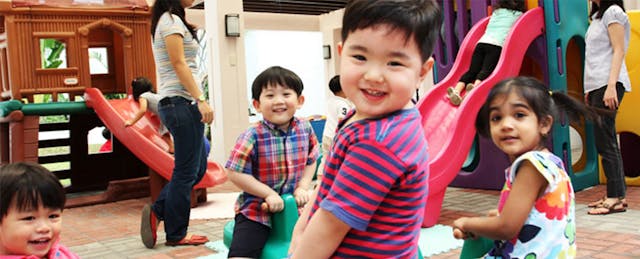Technology use in early learning offers promising opportunities—and lots of unanswered questions. Preschool classrooms are usually crowded and chaotic. There is often one lead teacher for fifteen or twenty children, making individualized instruction difficult. Many preschools have mixed-age classrooms, with not-yet-three-year-olds playing and learning alongside five-year-olds, and it can be difficult to tell exactly what a child knows and where they need to go next.
Carefully integrated technology offers an opportunity to demystify what children know while providing feedback and instruction calibrated to the child. So, conducting research on the use of tablets for early learning is an exciting challenge which requires intensive collaboration across disciplines, as well as immersion in the target context.
After hundreds of hours of playtesting and many iterations, the team at the Next Generation Preschool Math Project (NGPM), a combination of game and curriculum designers and researchers, is releasing a free suite of evidence-based early math app for preschools, Early Math with Gracie & FriendsTM. The first of the 8 apps launches today, with a new app rolling out every few weeks through the end of the year.
Fresh from the frontlines (and three years of research and development), the team offers seven guiding principles for effective design-based research.
1. Blueprint your learning goals
Be honest about your goal: Is it learning? If so, then blueprint your learning goals with scientists and content experts. Your blueprint should take into account the best early learning research in your content area, as well as evidence-based practices in technology use. Make sure the game design team buys into the blueprint as the starting point and revisits it regularly throughout the design process.
2. Prototypes, including those you throw away, are critical
Prototype relentlessly. Forget rounds of endless spec’ing and testing in the studio: Make something quickly, and get it into the hands of your target group. We prototyped 50 digital interactives and over 100 hands-on activities before whittling materials down to 8 apps and 46 hands-on activities.
3. Go beyond market research: inform the field
Include a mix of user testing and researcher-led pilot testing throughout the process, and ensure the focus remains on determining what’s working and what needs to be improved. Half of NGPM’s budget went to research, which included ongoing user testing, pilot testing the individual units and a small rigorous experiment (a randomized control trial). This is not market research, which benefits the distribution of your product, but ongoing formative testing, which improves the product and helps build the foundation for the field of early learning with technology.
4. Teachers can profoundly influence your product--if you let them
Create space to engage with teachers, and for them to improvise. Some of our best moments in NGPM happened when we handed a fresh and rough prototype to a teacher, and she learned the app along with the class. Not only did this approach engage the teacher more in the game play, it exposed the flaws in our design immediately. And after a testing session, debrief with the teacher, even if only for a minute: Do not underestimate the role of the teacher in mediating learning with technology.
5. The learning blueprint is your anchor, but don’t let it sink you
Embrace the often-difficult dialectic between achieving learning goals and maintaining engagement. It is critical to use the learning blueprint as the anchor for design, but it is just as critical to let a game be a game, and not a didactic experience. In our game City Skate, for example, as levels advance, both the math and game mechanic gets more difficult. The team did not want difficulty with the game mechanic to interfere with a child’s ability to advance to the higher math tasks. And yet difficulty with the game mechanic is part of what keeps children playing.
6. Collaborative learning with technology is messy, and necessary
Get comfortable with imperfection, especially when designing for collaborative play. There are so many variables in designing learning experiences: no two learners, no two teachers, no two classrooms are the same. Preschool learning is social learning, and learning with technology is best when it aligns with the natural social play patterns of this age. Though success in a game can largely depend on the culture of collaboration that the teacher infused (or didn’t) in the classroom, a collaborative game like Treasure Bubbles (to be released in November) can immerse children in a valuable shared learning challenge.
7. Treat your preschool customers with sensitivity
Be mindful of your customers. If you are creating learning experiences for the preschool classroom, be mindful of the sensitivities when working with this age group. Four-year olds (and their teachers!) respond well to consistency and caring. Seek to establish an ongoing relationship – it will benefit your team as much as your product!


